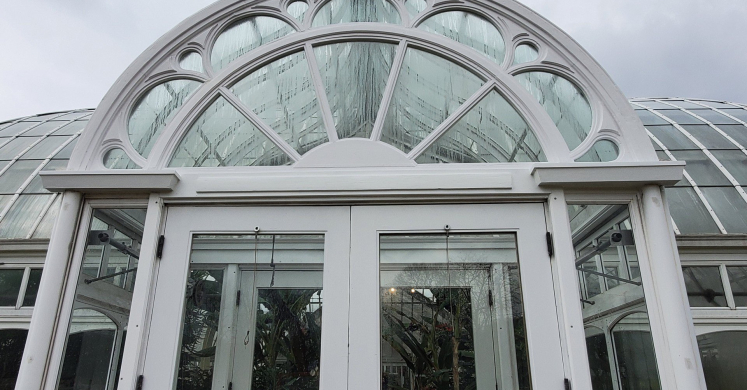Blog

The Return of Phipps’ Face to the East
The Victoria Room transom is an often overlooked piece of Phipps Conservatory. Read on for a look at the history and restoration behind this newly renovated section of the Conservatory!
You may have noticed some changes going on in and around Phipps Conservatory recently — some less noticeable than others. While our Broderie Room was closed for renovations this summer and fall, another piece of Phipps history was being transformed behind the scenes. The Victoria Room transom window has undergone significant restoration for the first time since Phipps was first completed in 1893. While some guests may barely notice this small section of the conservatory, the history behind it is extensive - and quite interesting!
To start off, what exactly is a transom window? Transom windows were introduced in the 14th century as a way for sunlight to enter a room without passersby glimpsing into the space. These windows were typically simple in fashion and meant to be a complement to the design of the building while still providing some light and ventilation. One such window exists in the doorway that leads from the Victoria Room to our Aquatic Garden; while guests don't use this door as an entrance and exit point anymore, it's a favorite spot for wedding photography and provides the centerpiece to Phipps' east-facing side.
Phipps is currently involved in an ongoing effort to restore its original glasshouse to the way it originally looked in 1893. The conservatory was operated by the City of Pittsburgh for its first 100 years; in 1993, when Phipps moved to nonprofit management and began to be able to raise funds to aid in the restoration of the historic building. Since then, restoration has been taking place room by room. Some visitors may remember in 2018 when the ogee crest was restored on the top of Palm Court, returning the conservatory back to what it really looked like 100 years ago. These same efforts are taking place now in the East wing of the Conservatory.
Restoring a historical glasshouse is no small feat, which is why Phipps works with historic greenhouse/glasshouse consultant Jim Smith of Montgomery Smith, Inc. Smith has over 35 years of experience in glasshouse restoration and assessment with his focus being on structures by Lord & Burnham — the firm that designed Phipps Conservatory. Smith’s expertise during the restoration process was especially helpful as the transom was an important piece of the original conservatory. The window dates to the original fabrication of the conservatory in 1892 and had never undergone a full, historically-accurate restoration. In order to properly repair the transom, it was removed from the vestibule it sat above and transported to Kentucky where Montgomery Smith, Inc. began work.
What was originally estimated to take 50 shop hours turned into almost 100 shop hours! Extensive damage to the bottom third of the window required replacement with kiln-dried pressure treated wood. The glass was also replaced with laminated glass to protect against breakage and better insulate the conservatory. However, one of the biggest surprises of the restoration was hidden underneath 16 layers of paint that had accumulated over the 129-year history of the window. The pinnacle of the window is covered top to bottom with an intricate carving that had gotten lost under the years of paint! Once these layers had been removed, the details of the original carving were revealed. When the transom was removed for repair, Smith also found untouched script written by a carpenter from 1892 which included an arrow and the words “Top This Side!” After two weeks of work, the window was finally transported back to Pittsburgh. This process required a special frame on the back of a trailer and was sure to turn some heads on the highway as it made its way back to the conservatory!
With the restoration complete, Phipps’ “face to the East” has now returned. Guests of Phipps Conservatory can view this amazing piece of history by making a special trip to the outside of the East wing and looking up above the doors leading to the Victoria Room.

